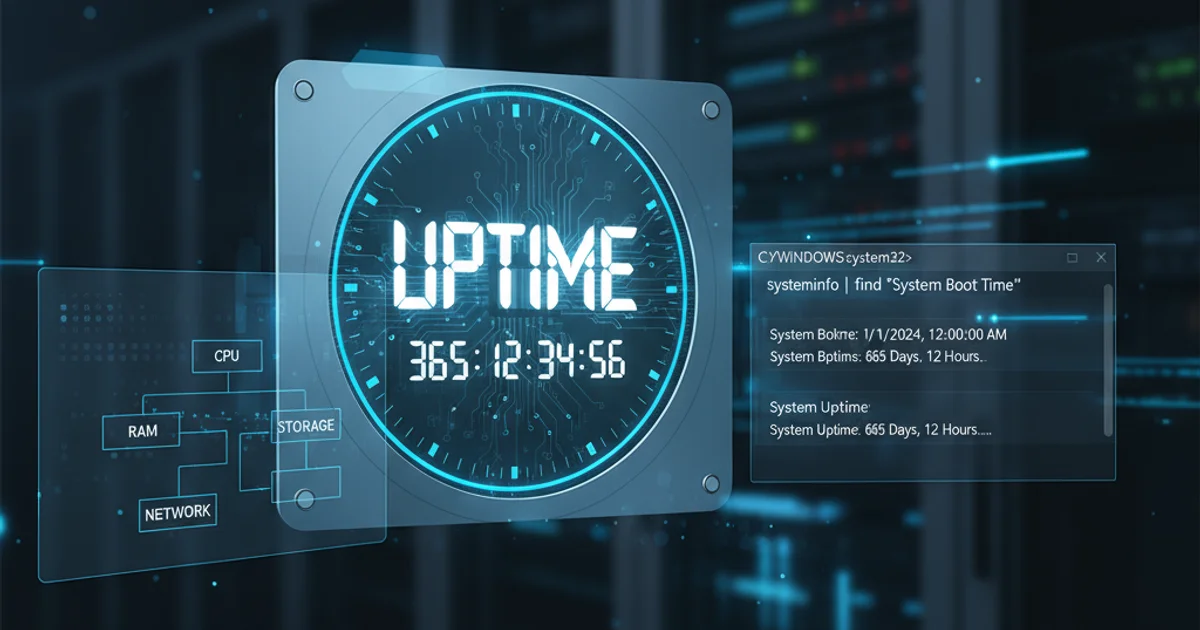How to get the system uptime in Windows?
Categories:
How to Get System Uptime in Windows

Learn various methods to check your Windows system's uptime, from simple GUI tools to powerful command-line utilities and PowerShell scripts.
Understanding your system's uptime is crucial for various reasons, including troubleshooting, performance monitoring, and verifying system stability after updates or reboots. Windows offers several built-in methods to retrieve this information, catering to different user preferences and technical skill levels. This article will guide you through the most common and effective ways to check how long your Windows machine has been running since its last restart.
Method 1: Task Manager (GUI)
The Task Manager provides a quick and easy graphical way to view your system's uptime. This method is ideal for users who prefer a visual interface and don't need to automate the process.
1. Open Task Manager
Press Ctrl + Shift + Esc or right-click on the taskbar and select 'Task Manager'.
2. Navigate to Performance Tab
In the Task Manager window, click on the 'Performance' tab. If you see a simplified view, click 'More details' first.
3. Find Uptime
Select 'CPU' from the left-hand pane. On the right side, under the 'Up time' label, you will see the duration your system has been running in Days:Hours:Minutes:Seconds format.
Method 2: Command Prompt (CMD)
For those who are comfortable with the command line, the Command Prompt offers a straightforward way to get uptime information using the systeminfo command. This method is useful for scripting or quick checks without a GUI.
systeminfo | find "System Boot Time"
Using systeminfo to filter for system boot time.
This command will display the exact date and time your system was last booted. To calculate the uptime, you would then compare this boot time with the current time. Alternatively, you can use the net stats workstation command for a more direct uptime display.
net stats workstation | find "Statistics since"
Using net stats workstation to find the 'Statistics since' entry.
The output of net stats workstation will show 'Statistics since [Date and Time]', which indicates when the workstation service was started, effectively representing the system's uptime.
Method 3: PowerShell
PowerShell provides powerful and flexible ways to retrieve system information, including uptime. It's particularly useful for administrators and advanced users who need to script or automate tasks.
(Get-Date) - (Get-CimInstance Win32_OperatingSystem).LastBootUpTime
PowerShell command to calculate uptime by subtracting boot time from current time.
This PowerShell command directly calculates the time difference between the current date and time and the system's last boot-up time, providing a TimeSpan object that clearly shows days, hours, minutes, and seconds.
Get-CimInstance Win32_OperatingSystem cmdlet is a versatile tool for querying various operating system properties, including LastBootUpTime.flowchart TD
A[Start] --> B{Choose Method}
B -->|Task Manager| C[Open Task Manager]
C --> D[Go to Performance Tab]
D --> E[View CPU Uptime]
B -->|Command Prompt| F[Open CMD]
F --> G["Run `systeminfo | find \"System Boot Time\"`"]
B -->|PowerShell| H[Open PowerShell]
H --> I["Run `(Get-Date) - (Get-CimInstance Win32_OperatingSystem).LastBootUpTime`"]
E --> J[End]
G --> J
I --> JFlowchart of different methods to check Windows system uptime.
Each method offers a reliable way to determine your Windows system's uptime. Choose the one that best fits your immediate needs or integrates seamlessly into your workflow. Whether you prefer a graphical interface or command-line efficiency, Windows provides the tools to keep you informed about your system's operational status.